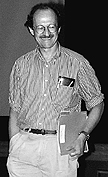

| T H E N I H C A T A L Y S T | J U L Y - A U G U S T 1999 |
|
|
|
NIH MORPHS GRADUATE SCHOOL IDEA |
by Fran Pollner |
 |
On the Front Lines:
Harold Varmus (top) and Michael Gottesman fielded questions at the
town meeting in May on an NIH graduate school.
|
 |
More people registered deight than dejection over the notion of NIH’s creating its own graduate school—both at an NIH-wide town meeting May 24 and two weeks later at a meeting of the Advisory Committee to the Director (ACD) of NIH—but the nays had it, anyway.
"The negative votes here count heavily—this is not majority rule," NIH Director Harold Varmus told his advisory group after three of its 16 members voted in a straw poll that NIH drop the idea.
"I basically think that [establishing a graduate school] is the right thing to do, but it must be done in the right way," Varmus said, observing that "it’s very difficult for us to do something in the intramural research program" in the face of opposition and reservations from members of the extramural research community.
His comments foreshadowed the decision that would emerge several weeks later that "rather than seek degree-granting authority for NIH, we will focus on improving all aspects of our present graduate and postgraduate programs and on improving and forging relationships with partner universities" (see DDIR column).
That decision was in tune with much of the advice of Princeton (N.J.) University molecular biologist Shirley Tilghman, the ACD’s self-described "most vocal critic" of an NIH graduate school—as well as some of the suggestions offered during the town meeting to bring more cohesion to both the training and the social environment of students now enrolled in existing programs on campus.
Varmus and Deputy Director for Intramural Research Michael Gottesman believe that NIH is uniquely qualified to fill gaps in the country’s doctoral ranks of individuals versed in bioinformatics, genomics, and clinical research—the three target areas of the proposed graduate school. At the ACD meeting, Tilghman argued that NIH should develop advanced programs to augment the training of those who already have their advanced degrees, not create a whole new graduate school.
At one point, however,
Tilghman conceded that were NIH to pursue creating a "true Ph.D. in bioinformatics,
I would be extremely enthusiastic. It could be called ‘computational biology.’
NIH could pilot such a Ph.D. program," she said. ![]()